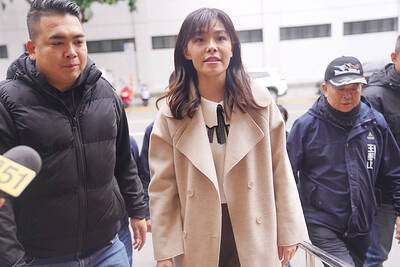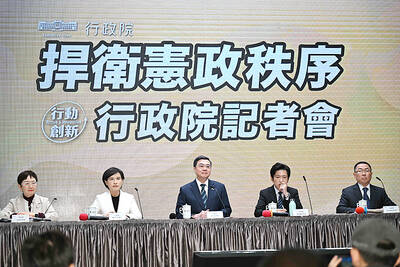As part of a push for the modernization of Taiwan's armed forces, the Chungshan Institute of Science and Technology (CSIST) has successfully developed new hardware, which it says will feature on the "brave new battlefield" of digital weaponry in the next century.
The equipment, currently being showcased at the Taipei World Trade Center, features newly-developed products such as a tactical data terminal system (TDTS), a C4ISR (command, control, communications, computer, intelligence, surveillance and reconnaissance) system, and an unmanned aerial vehicle (UAV).
The TDTS comprises a locally-developed helmet-mounted imaging system, for use by individual soldiers, which can transmit real-time visual and audio information to military command centers from the battlefield.
"The helmet imaging system, which is comprised of two cameras covering both day and night use, will become standard equipment for soldiers in reconnaissance platoons of the army's Combined Arms Brigade," said Luke Liou (
"We expect the equipment will be deployed by 2002. But we have yet to negotiate costs with the army. To equip each soldier with the helmet imaging system will cost hundreds of thousands of dollars, not to mention the additional costs of accessories, including a portable computer and a global positioning system (GPS)," Liou said.
Despite the potentially high price of the system, Liou strongly recommended its use in forward-observation missions, which are sometimes carried out by soldiers under threat of enemy fire.
The TDTS also includes a computerized battlefield management system, which would give a field commander real-time data on the deployment and movement of troops on the battlefield.
The backbone of the wireless communications is a CSIST-produced "frequency-hopping radio system" capable of transmitting data and digitized voice and video.
"With the system, a field commander can keep a close eye on combat situations. But it is not immune to intrusion by the enemy," Liou said. He declined to reveal, however, how potential enemies would be able to get into the system, but added that the equipment would be capable of rendering itself inoperable in the event of enemy capture.
Named the Chunghsiang II (中翔二號), the UAV is another piece of equipment CSIST is hoping Taiwan's armed forces will invest in.
"The army, navy and Coast Guard Command are all interested in buying the vehicle, which can provide day and night reconnaissance, battlefield surveillance and target acquisition," said Robert Liu (
"It can be very useful for the coast guard, since it can carry out reconnaissance missions night and day regardless of terrain restrictions," he said. "Only a small number are needed to cover the whole coastline of Taiwan."
"The vehicle, when fitted with high-resolution cameras, could perform aerial photography missions normally undertaken by the air force," he said.

The US government has signed defense cooperation agreements with Japan and the Philippines to boost the deterrence capabilities of countries in the first island chain, a report by the National Security Bureau (NSB) showed. The main countries on the first island chain include the two nations and Taiwan. The bureau is to present the report at a meeting of the legislature’s Foreign Affairs and National Defense Committee tomorrow. The US military has deployed Typhon missile systems to Japan’s Yamaguchi Prefecture and Zambales province in the Philippines during their joint military exercises. It has also installed NMESIS anti-ship systems in Japan’s Okinawa

‘WIN-WIN’: The Philippines, and central and eastern European countries are important potential drone cooperation partners, Minister of Foreign Affairs Lin Chia-lung said Minister of Foreign Affairs Lin Chia-lung (林佳龍) in an interview published yesterday confirmed that there are joint ventures between Taiwan and Poland in the drone industry. Lin made the remark in an exclusive interview with the Chinese-language Liberty Times (the Taipei Times’ sister paper). The government-backed Taiwan Excellence Drone International Business Opportunities Alliance and the Polish Chamber of Unmanned Systems on Wednesday last week signed a memorandum of understanding in Poland to develop a “non-China” supply chain for drones and work together on key technologies. Asked if Taiwan prioritized Poland among central and eastern European countries in drone collaboration, Lin

BACK TO WORK? Prosecutors said they are considering filing an appeal, while the Hsinchu City Government said it has applied for Ann Kao’s reinstatement as mayor The High Court yesterday found suspended Hsinchu mayor Ann Kao (高虹安) not guilty of embezzling assistant fees, reducing her sentence to six months in prison commutable to a fine from seven years and four months. The verdict acquitted Kao of the corruption charge, but found her guilty of causing a public official to commit document forgery. The High Prosecutors’ Office said it is reviewing the ruling and considering whether to file an appeal. The Taipei District Court in July last year sentenced Kao to seven years and four months in prison, along with a four-year deprivation of civil rights, for contravening the Anti-Corruption

NO CONFIDENCE MOTION? The premier said that being toppled by the legislature for defending the Constitution would be a democratic badge of honor for him Premier Cho Jung-tai (卓榮泰) yesterday announced that the Cabinet would not countersign the amendments to the local revenue-sharing law passed by the Legislative Yuan last month. Cho said the decision not to countersign the amendments to the Act Governing the Allocation of Government Revenues and Expenditures (財政收支劃分法) was made in accordance with the Constitution. “The decision aims to safeguard our Constitution,” he said. The Constitution stipulates the president shall, in accordance with law, promulgate laws and issue mandates with the countersignature of the head of the Executive Yuan, or with the countersignatures of both the head of the Executive Yuan and ministers or